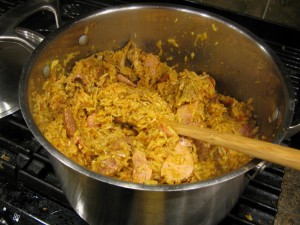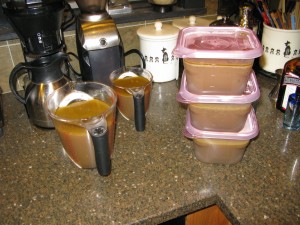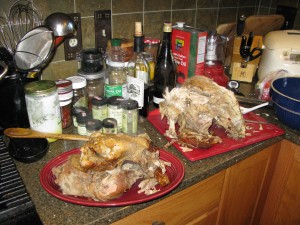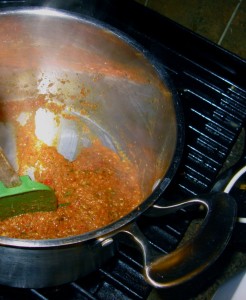What Do You Do When Your Turkey Is Too Big?
Well, if you live at my house and you were blessed with a turkey too big for the number of guests at your Thanksgiving dinner, you strip what extra meat you want from the bird, pop the rest in a pot, make stock and then…make jambalaya. (I grew up in a household where we used turkey leavings to make turkey rice soup on the Sunday after Thanksgiving. Must be part of why I make jambalaya–because turkey and rice are imprinted as perfect partners in my brain…..)
Now, I’ve written about jambalaya before, and while the recipe I presented previously is a perfectly good rendition of the dish–this one is spectacular. There are several notable differences between this jambalaya recipe and my previous one, and they are as follows:
1. This recipe uses a freshly made stock from a turkey carcass, a ham bone and some leftover smoked barbecue rib bones from Kiser’s BBQ Shack here in town, instead of a simple chicken stock. This results in a richer, more fully-flavored jambalaya.
2. Instead of finely dicing the aromatics and vegetables, I pureed them, which is something hardly anyone I know of does. But I have found that the jambalaya made this way is more deeply flavored, in large part because the tiny pieces of vegetables cling to each piece of rice and turn each grain into a little flavor bomb that explodes on your tongue. Good stuff, right there.
3. I used way more herbs and spices, including Spanish smoked paprika (pimenton), cayenne pepper, Aleppo pepper and tarragon, in this version, which added another several layer of flavor and aroma to this recipe.
So, first of all, let’s talk about the turkey stock.
I’m not going to go into a full description of how to make stock here, because I already wrote that post a while back–like about four years ago. So, for a long, drawn out and involved treatise on the general method of making stock (in four part harmony with full orchestration), go here.
Now that you’ve read the background information, let’s go back to talking about turkey leftovers and turkey stock.
First, pick off all the meat you want to use, and peel off most of the skin. Leave some of the skin on, though, because that nice roasty color and flavor that is in the skin will get into your stock and make it really, really tasty. Trust me on this. You want all the browned meat flavor you can get in your stock.
Stock made this way, from a carcass of a roasted bird, is technically called “fond brun” in French kitchens–brown stock. It gets its color from the roasted bones it is made out of. And–you can turn any stock you want to make brown even if you are only using uncooked bones–to do that, just roast those bones with some carrots, onions and celery in a hot oven until they brown and smell meaty and good. Then continue onward and make your stock as written. I personally think it is a waste to make beef stock without browning the bones at least a little, but that is another post for another time.
Okay, back to making the turkey stock. After you peel off as much of the skin as you want to, and remove as much visible fat as you would like, crack the carcass apart so it will fit more nicely into the stockpot. Whole turkey skeletons don’t usually fit into stockpots well, so I usually hack off the legs and thighs, twist off the wings and if I have a cleaver that will go through the backbone and breastbone, hack through the main body. Then, the pieces go into the stockpot without any argument. (Who argues with a woman with a cleaver, anyway?)
Into the pot also goes the usual whole carrots, celery and onions (if, like some people, you put these vegetables in the bottom of your roasting pan to make the drippings taste nice, save those suckers and use them in your stock!) and in my case, a couple of garlic cloves. Herbs go in as well–fresh or dried thyme, rosemary, sage, bay leaves and tarragon, as well as some spices: a dash of cayenne, a teaspoon or so of Spanish smoked paprika, and a tablespoon of Aleppo pepper. In addition to all of this, when I know I am making jambalaya with my stock, in goes a whole chile pepper or two–in this case a couple of green serranos.
Then, I usually add what drippings I have saved from the bottom of the pan–because I don’t usually use all of them for the gravy–as well as any leftover gravy that hasn’t been eaten. If you didn’t simmer all of the goodness out of the turkey neck on Thanksgiving day, toss that in, too. (Do you get the idea that I save everything? There’s a good reason for this–I do.) Then, a ham bone or ham hock, and if you happen to have some smoked pork ribs, those can go in, too. But, if not, the ham bone or hock will do just fine.
Why do I put pork into my turkey stock?
I have found over the years, that I prefer the flavor of a mixed pork and poultry stock better than I like just plain poultry stocks. I got the taste for such stocks from eating lots of really good Chinese soups and sauces made with such mixed stocks. There is something fuller and more delightful about a mixed pork and chicken or turkey stock, than one made with the bird bones alone that I find adds a mysterious, amazing touch to any dish cooked with the stock.
That said, if you don’t eat piggies for whatever reason, then, leave off with the pork bones and don’t worry over it. It will all turn out okay.
Then, the bones, meat, vegetables and other stock stuff is all covered with cold water to which about a cup of sherry and a cup of dry red wine are added. Why both? Why not? Both sherry and wine really make the stock taste good, so if you have them on hand, go for it!
Now-most of the time, you add some salt to the stockpot just before you start simmering it–but let me caution you–if you brined your bird, don’t even go there. Don’t ever add salt to the stock until it is done and you have tasted it. You run the risk of making your stock too salty and that is just a hideous crime and a shame because you waste all your nice stock and all the effort you put into making it.
Then, you bring your pot to a simmer, turn the heat down and simmer it for as long as you can stand it. With a turkey stock made from a roasted carcass with plenty of meat left on it and some good smoked pork bones, you can make a deep, dark stock in about three to five hours of simmering. But, if you want, you can always simmer it longer.
After your stock has cooked as long as you want it, follow the general stock making instructions here to remove the remaining meat from the bones, and strain the stock.
For this jambalaya, you will need six cups (1 1/2 quarts) of stock. I ended up making about five quarts of stock, which is great, because I could freeze what I wasn’t going to use now for later soup-making adventures. I also ended up picking off an extra quart of meat which I also packed up (with some broth to keep it happy and moist) and popped in the freezer, with the intention of some mole poblano enchiladas appearing on my table later this winter. This extra quart of meat came after the quart and a half of shredded chunks and bits of turkey I stripped from the bones for the jambalaya. So, from this harvest from one bird, you can guess that it was way bigger than necessary….but then, really, what is necessary? It isn’t like any of it is going to waste….
After you have picked your meat and strained your stock, you are left with bones and skin. Give the skin to your pets, but not the bones. That said, I have found that chucking the bones into the woods makes the crows, raccoons and possums very happy, but some folks might frown on that, so you’d best just throw them away.
Now that we’ve gone over all of that, we can start making the jambalaya!
This recipe makes enough to feed six to twelve people. I say six to twelve, because it depends on the people. If you have folks who don’t eat a lot, like elderly grandmothers and little toddlers, then you can definitely stretch the jambalaya out to feed more of them. If you only have big burly lumberjack sorts, you might have to stop at six. If you have normal folks who just really like jambalaya, this recipe will probably serve eight.
This said, please note that in order to feed more people with a pot of jambalaya, you can always add more meat. More of the same, or more of different sorts of meat–for example, this recipe has the leftover dark and white meat from a turkey, plus about a half pound of really good local ham and a pound of local andouille sausage. (Okay, the truth is this–you can make this jambalaya with just turkey meat. But, see, I think that is sad. That turkey might just be lonely in that pot all by himself. So, please, toss in at least a bit of ham and sausage to you, know, just keep that bird company.)
But, if you have other stuff around, like, oh, a venison roast, preferably with a bone in it, toss that in the stockpot, then shred the meat off of it. Or, add some seafood (though you have to understand that I will be eternally jealous of you, as I have developed an allergy to shellfish), or some chicken, or some duck–you get the picture.
You can also add more rice and stock to the recipe. That’s usually cheaper than adding meat, but leftovers are only ennobled by being chucked into the jambalaya pot and leftovers are cheap, being as they are left over from a meal already paid for and eaten. But still, if you want to add more rice and stock–the ratio you must remember is 2:1–two parts stock to one part long grain (I use jasmine, because that is what lives in my pantry) rice. Don’t get that backwards, please. It will make a scorched, stinky mess and you might get mad at me. So, I reiterate: the ratio is 2:1 stock to rice.
Okay, now we are ready to make jambalaya!
Laissez les bon temps rouler!
After Thanksgiving Turkey Jambalaya
Ingredients:
1 really large red bell pepper, seeded, with the stalk removed, and cut into chunks
1 really large yellow onion, peeled and cut into chunks
3 big stalks of celery, strings removed and cut into chunks
2-5 serrano chiles, stalks removed, and seeded if you like
1 head of garlic, peeled (that is head, not clove. One clove is that one piece of garlic you take out of the head of garlic–I want you to use the whole darned head here.)
4 tablespoons olive oil
1 tablespoon Aleppo pepper flakes
1/2 tablespoon Spanish smoked paprika
1/2 teaspoon cayenne pepper
1 teaspoon ground turmeric
3 tablespoons fresh rosemary, minced (or 1 teaspoon dried, powdered)
3 tablespoons fresh thyme leaves, or 2 teaspoons dried
3 fresh sage leaves, minced (or 1/2 teaspoon dried, rubbed sage)
1 tablespoon fresh tarragon leaves, minced–or 2 teaspoons dried
1 pound andouille or other smoked sausage, cut in half longways, then into diagonal slices
1/2 pound ham, diced
3 cups jasmine or other long grained rice
6 cups strained (and salted to taste) turkey stock
2 pounds (about a quart and a half) shredded dark and light meat turkey, preferably that has been simmered in the stockpot (it makes it more moist to use it after you have made the stock)
salt to taste
minced fresh parsley and scallion tops for garnish
Method:
In a food processor, puree the pepper, onion, celery, chiles and garlic. You will end up with a frothy, very liquidy, fragrant red mixture. Good. That’s what you want it to look like.
Heat your olive oil over high flame in the bottom of a heavy-bottomed stock-pot–I use a ten quart pot for making jambalaya–and when it shimmers, add the puree. It will sputter, spray and make all sorts of noises, but dive in bravely and stir, stir, stir, the whole time it cooks. Turn down the heat to medium and cook, stirring. You will notice that there is a lot of steam and bubbling–that is what you want. The water is simmering right out of your vegetable mixture. When the mixture has reduced by about half, you will notice it has gotten thicker, but is still sort of juicy. At this point in the cooking is when you add the herbs and spices.
Continue cooking until it mostly stops sputtering and whispering at you, and stir carefully. The mixture will be much thicker and you will note that it has started taking on a bit of a darker, more golden-brownish tinge. That’s because most of the water is gone and everything is starting to brown a bit.
At the point where your spoon leaves a definite trail that shows the bottom of the pot, (see photo above) and when that trail does not instantly disappear–add the sausage and ham. After it browns lightly for a minute or two, add the rice, all at once. Then, you stir it completely to coat each grain of rice with the oil and vegetable mixture. You keep cooking, and stirring until the rice has a shiny, somewhat translucent tinge to it and you can smell a nutty fragrance coming from it.
That’s when the stock gets poured in all at once. Stir to make sure that the rice is all covered and mixed into the stock, bring the heat up onto high again, and bring it to a boil. Then, clap a lid on the pot, and turn the heat down to low and leave the pot alone. No, really, I mean it.
Now you start timing it–sort of. Here’s where the recipe gets a little variable, because I don’t know how fresh your rice is, nor how low your stove goes. The rice will cook in between 10 for very fresh rice with an electric stove that doesn’t cool down very fast to 20-25 minutes for a gas stove and average rice. Most of the time for me, the jambalaya cooks in about 20 minutes or so. So, what you do, is simmer the pot for ten minutes. Check the rice at that time–most of the time, what you will see is half-cooked rice just covered with about an inch or so of rapidly disappearing stock. If that is the case, spread your turkey over the top and clap the lid over the top and let it cook, under supervision (in other words, check on it now and again) for another ten minutes. At that point your stock should be absorbed, your turkey should be steamed and lovely and all should be tasty. If the rice is still a little underdone, sprinkle in about 1/4-1/2 cup more stock or water over the rice, stir it well and close the lid and let it cook another five minutes. After that, it will be done.
If, when you check the rice after the first ten minutes, it is tender and done, then stir in your turkey and continue cooking for about five more minutes, stirring constantly to keep it from burning to the bottom of the pot, so as to heat up the turkey nicely.
At this point, taste for salt and correct the seasoning. Sprinkle with the parsley and scallion tops and serve with a smile.
6 Comments
RSS feed for comments on this post.
Sorry, the comment form is closed at this time.
Powered by WordPress. Graphics by Zak Kramer.
Design update by Daniel Trout.
Entries and comments feeds.







“That said, if you don’t eat piggies for whatever reason, then, leave off with the pork bones and don’t worry over it. It will all turn out okay.”
“Okay” being the operative term here. Piggy makes it go from “okay” to “oh, yeah!”
Comment by Zak — December 1, 2010 #
I made a ton of turkey stock with our huge bird, too. I never thought of adding smoked pork to it, though, and I have several chunks in the freezer (mostly butt ends) from the pastured hog we ordered last month. It is SO going into the next poultry stock I make.
Comment by Jan — December 1, 2010 #
Your recipe, Barbara, may be the first I have seen that may top ours for leftover turkey. Our tradition is to make turkey enchiladas or burritos making our own sauce, salsa and adding cheese, sour cream, black olives, avocados, onions, garlic. That usually takes care of what was left of the bird. For both the main event and the followup dinner we leave with smiles on our faces. I wonder what they would think of jambalaya next time.
Comment by Maureen — December 1, 2010 #
So glad to see you writing again – I’ve been following you for at least the last four to five years, and remember the stock recipe from when you first ran it.
However – I’ve been wondering about a good technique to make a vegetarian stock? Is that something that you’ve tackled or would consider tackling? I’d be forever indebted.
I think this is only my second or third time commenting on the blog, ever.. but rest assured, you’ve been a part of my weekly reading schedule since the beginning!
Comment by Sania — December 8, 2010 #
Sania, thank you for commenting–and thank you for being such a loyal reader! That means a great deal to me. It always makes me very happy to know that I have helped teach people valuable cooking techniques.
I will do a vegetable stock/broth post in the near future–I hadn’t thought to do it before, but you are right–it is a worthy subject. Maybe I will put one up on Monday, it being the “meatless” day at T&S!
Comment by Barbara — December 8, 2010 #
Hi Barbara,
When Tessa called to tell me you started the blog again, I was thrilled. Glad you are feeling well and life is good. Karl is cooking for us this weekend. Best to Peter and the crew.
David
Comment by David Rosenblatt — December 13, 2010 #